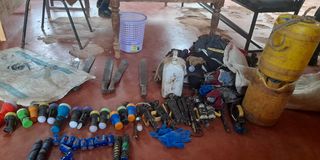How drought in Tsavo is fuelling game meat trade

Some of the weapons used by poachers to kill wildlife for game meat at the Voi Law Courts.
The prolonged drought that has affected wildlife and humans has aided the trade in bush meat, affecting small game in the Tsavo Conservation Area (TCA).
The unprecedented dry spell has led to greater poaching in the country's largest ecosystem, with dik-diks bearing the brunt of the illegal trade, data from the Kenya Wildlife Service (KWS) shows.
Between September 2021 and October 2022, some 1,800 dik-diks were killed.
Other most hunted species for bush meat were zebras, elands, impalas, oryx, giraffes, gerenuks and lesser kudus and buffaloes, endangering the species.
Despite the trail of death caused by the drought, poachers have taken advantage of the situation to kill animals for game meat, said Captain Kenneth Ochieng, the KWS assistant director for the TCA.
He said communities in the area have resorted to poaching to support their families due to high poverty levels.
"We have seen a serious increase in cases of poaching. We are relating this to the increase in poverty levels, because people cannot harvest anything from their farms due to the dry spell, so they are resorting to poaching to put food on the table," he said.
Poachers are armed with enhanced high-powered led lights to catch the animals and sell the meat in the black market, he added.
He said the situation could worsen if the next rainy season fails.
"We're into a rainy season, but it is erratic. We're not sure whether the rains will last for a long time or just a few weeks. That tells you that we need to prepare in case the dry spell continues," he said.
Besides poaching, the Tsavo ecosystem lost over 179 wildlife because of the drought between January and October, with September recording the highest mortality of 98 animals.
The KWS said the ecosystem lost 110 elephants and 32 buffaloes from the effects of the severe drought during the 10 months.
The figures represent only what the conservation body was able to detect, Mr Ochieng said, noting that there could be more cases that went unrecorded.
Climate change has become a major challenge to conservation efforts as animals continue to be affected by drought.
"This year alone has experienced severe droughts compared to the previous ones. Elephants were the most affected species followed by buffaloes," he said.
The area has suffered its worst losses as water and pasture continue to decline.
"Even the boreholes we [dug] to mitigate the situation are drying up," he said.
But he added that the government has put in place measures to mitigate the effects of drought on wildlife.
Together with stakeholders, the KWS has started trucking water to wildlife. It has also announced plans to set up 12 more water pans in Tsavo National Park.
Plans are also underway to desilt the Aruba dam that dried up five years ago. The dam used to be a major water point for wildlife.
It is among 20 water points in the park that have dried up due to the ongoing drought.
Cases of human-wildlife conflict have also increased, Mr Ochieng said.





